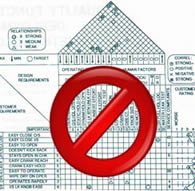Success by Design — That’s what QFD does!
Flipping TV channels one night I stumbled upon a panel discussion of design and its impact. Global leaders from various disciplines were adding their positions on this issue, including design-thinking expert Tim Brown's:
What impressed me most was the insistence that retroactive problem solving, while useful, is actually made necessary because products and processes were not designed right the first time. QFD (Quality Function Deployment), of course, was created specifically for this occasion.
Let's take a look at the various quality methods commonly recommended:
Six sigma DMAIC or another problem solving approach:
A problem with our product or process is identified by our internal people or reported by a customer. The focus is on "known knowns" that we control and can measure. The problems are related to current activities.
FMEA:
The design of a new product is examined for what could go wrong, and how to prevent it. The focus is on "known unknowns" that we must learn how to control and measure. The problems are related to both current and future activities.
QFD:
The design of a new product focuses on the problems and opportunities customers face, including image issues, and how we can improve the customer's situation. Since the customer is external, we must go to their gemba (where they work and live) to find the "unknown unknowns" so that our new product or process creates future value for them, as they define it.
In my experience, QFD is the only systematic approach to take the spoken and unspoken voice of the customer and transform it into critical design requirements, and then flow these requirements down to build / implementation / commercialization parameters and actions, including ongoing support and retirement.
Yes, there are many marketing instruments including sampling surveys, anthropological studies, VOC analytics, customers satisfaction surveys, focus groups, etc. But they focus on our product's interaction with customers more than on the customers themselves. While they produce interesting statistics and feedback, they stop at this point and throw the data over the wall to the engineering function. QFD, on the other hand, assures "quality" analysis every step of the way.
Here's how QFD works:
Goal Analysis
If done as Dr. Akao, founder of the method, instructs, QFD begins with the business or market opportunity (strategy, trends,hoshin, business plan) to clarify what the business or organization hopes to gain from this endeavor. Why was this project selected over others? In a business, this means profit, market share, etc. In an NGO (non-governmental organization) or government, this means doing something for humanity—addressing some aspect of "injustice, inequality and intolerance" as Ban Ki-moon, the UN Secretary General stated at the CGI conference.
Who Is Your Customer?
QFD must then identify who our customers are - end users, value chain of intermediate customers, internal customers, etc. and the importance of their role and voice in attaining the previously stated goals.
Voice of Customer (VoC)
What are your customers saying and doing in their lives and work? What problems do they face, what opportunities do they hope to grasp, what image do they wish to portray as they go about their everyday processes? What are they not telling us because they are afraid, they do not think we can help, or they do not know what is possible?
Customer Needs
Not all VoC are customer needs. This is critical to successful QFD. In fact, most VoC tend to be about customer happiness or unhappiness with today's products and services, because that is what we ask them. But customer needs should be independent of today's products and services, so that we can be creative and innovative in developing tomorrow's solutions.
Customer Priorities
Not all customer needs are equally important. Generally, customers would prefer we address what matters most to them, first and with best effort. Since we can probably make this best effort on only a small number of needs, it is critical to get accurate priorities from the customers. Modern Blitz QFD® has several new tools to help.
Don't ask customers to prioritize solutions, features, etc. That is not their domain of expertise and while they will try hard to help, at best they can only guess. Instead, get customers to prioritize their needs as defined above. This is where they are the experts, not you, and you have something to learn. Use the Customer Voice table.
Don't ask customers to assign weights or numbers. People do much better using natural language than trying to pick a number from 1-10 or 1-100 to express importance. Use the Analytic Hierarchy Process.
Don't tire your customers with long lists. They may start out honest, but will soon start faking responses to "get through" the list. Use the power of the Hierarchy diagram.
Technical Requirements
Now that we have a prioritized list of customer needs, we can transform these into product or process technical requirements. Classical QFD uses the House of Quality (HoQ) for this purpose.
Many seasoned QFD professionals have a love-hate relationship with the HoQ and other QFD matrices. They love the comprehensive analysis of how all customer needs and all technical requirements relate to each other, but they hate the amount of work needed to complete this matrix, which output can become useful only after all of the cells are correctly populated. I agree, the HoQ can be too tedious and time and resource-consuming for many of today's business projects, and now only recommend it for special cases.
House of Quality matrix is not required to implement QFD.
More often than not, one modern Blitz QFD® tool — Maximum Value table — can accomplish what classical QFD would take anywhere from 4 matrices (ASI model) to 30 matrices (GOAL/QPC approach) to do with much less time and effort. The key is focusing end-to-end on the customer's priorities though each phase of development, design, innovation, test, build, deliver, support, and retire.
When we follow these steps, we build in success as defined by the very customers and constituents we want to help. We focus our limited human, financial, and time resources where we get the "biggest bang for the buck."
Neither businesses nor NGOs nor governments can be everything to everybody. What we can do is be the best where it matters most.


